The Vault: Posts through August 2015
SPAM Bots took over the comments! But I am unhiding these temporarily.
|
Before Xmas, Explain Everything will cross 10,000 downloads. This is about 9,700 more than I would have predicted when I started putting together ideas for an iPad app around a year ago. Now that I am on break for the next two weeks (and I finished a draft of Chapter 2 of my dissertation), I thought I would use the time to write all about the process I went through - from conceptualization to development to design to marketing (of you can call it that) and more. This post is purely an introduction. I think it's important for teachers and students to be involved in the design of tools that might have a place in educational settings. That being said, I am not a programmer/developer/coder. The only programming class I have taken is an Introduction to Java that is a requirement for my degree program. However, I have taken the time to foster an understanding of object oriented programming which has been invaluable for my entire process, especially when communicating with developers and thinking about what might be possible based on already existing elements within a design. I also have always believed that the best tools are usually commercially made for entertainment and consumer audiences, and creative educators then appropriate those tools for teaching and learning environments. Some of my favorite pieces of software and games growing up were not explicitly designed for school settings, but the combination of an open-ended environment and problem solving required to succeed or use the tool well were a huge part of my learning. Explain Everything is not at all game. However, it is a helpful exercise for me to reflect on those things from the past that may have helped my interest in software and design. King's Quest I (for PC) 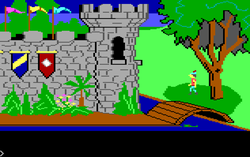 via Wikipedia I remember when we bought the 5.25 inch floppy disk program from Radio Shack and got it to run on our IBM PC jr. computer at home. King's Quest (and many of the games originally produced by Sierra) featured an open world that required exploring, thinking, finding objects, and using items to solve problems. Most objectives in the game had multiple solutions, and the type-command based interface left things open so the user had to try different combinations of commands in order to make things happen (e.g. "open door" or "give bowl to man"). A company called AGD Interactive has produced remakes of several Sierra games which are available for free (Mac and PC) and they also sell their own commercial games. The Legend of Zelda (for Nintendo) via Wikipedia I remember the original Legend of Zelda commercial on TV (Octorocks! Tektites!) but also remember I still had no idea what the game was about. I knew it came in a fancy gold cartridge, and that everyone in my 4th grade class was talking about it. Once my brother and I got it, we soon learned it was unlike any other Nintendo game in scope and design. There was no set order in which things had to be done (maybe with the exception of the dungeons) and the world was loaded with secret stores and goodies. I haven't played another Zelda game since the Nintendo 64 "Majora's Mask," but as I write this I am tempted to get the new one that is available for the Wii. Hero's Quest / Quest For Glory I (for PC) 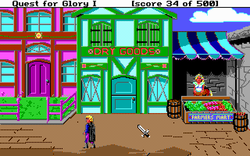 home.comcast.net/~ervind/qfgnames.html The original Hero's Quest game has since been renamed Quest for Glory due to a lawsuit and also remade as VGA version. Even though I had a Nintendo and lots of games I liked playing (even with better graphics), I was usually more happy playing Hero's Quest, another gem from Sierra, on my IBM PS/2 computer. In this game, you chose your character type (Fighter, Magician, or Thief) and sought to complete the quests available in the world in no predetermined order. Like King's Quest, there were many ways to solve a puzzle even within character types. There are now 5 Quest for Glory Games, and the second one was made into a free VGA download, again by AGD Interactive. Streetfighter 2 & Mortal Kombat 2 (for Sega Genesis) 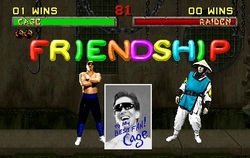 www.fightersgeneration.com It will be a stretch to say I had any real learning from playing hours and hours of playing fighting games. What these two particular games represent for me is a shift of things only being accessible in arcades to high quality games being accessible at home. My friends and I used to have to go to Sportsworld in Paramus, NJ and go through rolls of quarters in order to play these games. While the arcade audio and video was always higher than their console counterparts, my friends and I still were plenty happy playing Streetfighter 2 at all hours of the night. Goldeneye (for Nintendo 64) 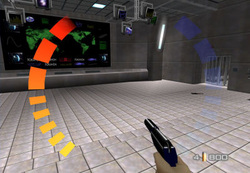 I did not get into Doom or Quake since by the time I was near the end of high school and early college I was not into computer games. However, I was aware that people at college were playing multiplayer games across the network (like Quake 2 and Worms).I did get a Nintendo 64 to keep at home (mostly to buy and play the new Mario game and The Legend of Zelda: Ocarina of Time). During the winter break of 1997 at a friend's house, I learned about how much fun multiplayer games are, especially well-designed FPS. Goldeneye was incredibly unique at the time, especially being able to support 4 players (a 2x2 split screen) playing in the same game at once. Counterstrike (for PC) 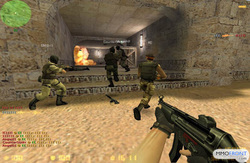 It should be said that I was actually not that good at the fighting and shooter games. I just really enjoyed being engaged in the environments created by the developers. Counterstrike, a multiplayer mod for the game Half-life (surprise surprise, another game by Sierra) was my first foray into team-based multiplayer interactions. Instead of being every-man for himself, you had to work with a team of others to defeat another team (defend an object, rescue hostages). I loved the social element of this game, including the trash talk of which I was usually on the receiving end. I still enjoy these types of games, including the Call of Duty series, but I don't have the time to dedicate to becoming really good at them. Grand Theft Auto III (for Playstation 2) 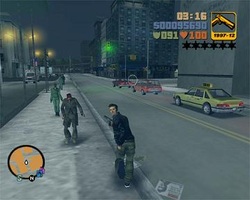 I just realized that the latter half of games I describe might be categorized under 'violent' video games. I would venture to say that it is the accessible and familiar design and the realism that makes them so interesting. Despite the publisher's wanting to push the boundaries of what is appropriate and how games are marketed to young people, I am still most captivated by the open environments in the Grand Theft Auto games. When GTA3 came out, it was like Legend of Zelda - I had never experienced a computer-simulated environment quite like it before. The subsequent versions, including the HD GTA IV and upcoming GTA V only build upon those experiences and environments. End of Introduction That reflection is just a small slice of the experiences that have directly or indirectly contributed to my design and function aesthetic. Next, I will write more specifically about the conceptualization process for Explain Everything.
0 Comments
Your comment will be posted after it is approved.
Leave a Reply. |
WatchFollowArchives
August 2015
Header photo by Robert S. Donovan
|